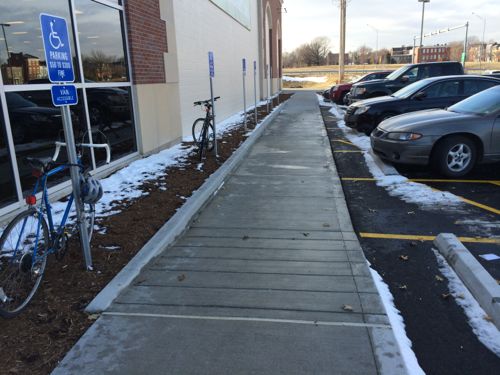Detectable Warning Overkill
Late last month I posted about a blatant ADA violation at Fields Foods, which remains at this time. At the grand opening I noticed one thing they got right that most get wrong: detachable warnings.

They got it right by not including detachable warnings? Yes, too often their use is misunderstood by architects & civil engineers:
Detectable warning surfaces consist of small truncated domes built in or applied to a walking surface that are detectable underfoot. On pedestrian access routes, detectable warning surfaces indicate the boundary between a pedestrian route and a vehicular route where there is a flush rather than a curbed connection for pedestrians who are blind or have low vision. The proposed guidelines require detectable warning surfaces to be installed on newly constructed and altered curb ramps and blended transitions at pedestrian street crossings. (Access Board)
The “at pedestrian street crossings” part is what’s often overlooked, resulting in detectable warnings being used far too often. Here’s two recent examples:


You’re probably thinking, “So what?” These are used by the visually impaired to locate street crossings. They feel the truncated domes through their shoes to know the direction to walk to cross the street. The last two examples above are overkill.
Clearly there’s lots of confusion out there:
Q: Regarding detectable warnings, you use the word “street.” What about parking lots? And are drive islands [that separate driveways in parking garages or other parking lot structures] considered streets? I’ve also used them when trash enclosures are behind the sidewalk, at drive-thru lanes, and in parking lots where there’s a row of handicap parking spaces with zero-inch curbs. I place them at all places where you could get hit by a car.
A: There’s a reason for stating “street,” and that is to prevent overuse. Detectable warnings are for actual street crossings, with the small exception of commercial driveways with traffic control devices. (Public Works magazine)
These truncated domes aren’t cheap, or free to install. Developers are paying extra to create confusing environments for the visually impaired. Developers, architects, engineers, plan reviewers, etc. need to pay attention to this issue. Ideally they’d have an ADA/pedestrian expert on their design team to avoid these mistakes.
— Steve Patterson
Steve, you should offer your expertise to developers as a hired consultant on pedestrian and ADA design.
I do!
I need an ADA consultant ASAP. How do I get a hold of you?
Top of the page, under the Urban Review STL header, hit the “contact” button . . .
I pulled up Wash U’s requirements for a degree in Architecture…..it requires 54 hours:Architectural Design Level 100 6 units, Architectural Design Level 200 6 units, Architectural Design Level 300 12 units, Architectural Design Level 400 12 units, Case Studies in Architecture 3 units, Building Systems I – 3 units, Structures I & II – 6 units, Site or Climate 3 units, Architecture Elective 3 units. One would think this would be covered in at least one of these classes.
But many moons ago, I was taken to task for suggesting that it is the Architects that should be educating their clients, not only on ADA, but on many aspects of design. Glad to see you’re coming around.
You weren’t “taken to task” by me, I agree architects & civil engineers need more education in this area! I’ve presented at a couple of AIA St. Louis events in the ADA.
Steve, most times Architects aren’t the ones responsible for the final product-the Regional ADA Coordinator has the final say for what degree of ADA implementation is constructed.
So give it a rest on us Architects, okay?
No, the architects & civil engineers are part of the problem. Passing the buck doesn’t work! The ADA is enforced through the US Dept of Justice, I’m assuming you’re taking about a coordinator that works for private companies like Walgreens because I don’t know of a local, regional, or state coordinator.
Steve, Steve, Steve…
How have YOU never met, interacted with, or even heard of the Regional ADA Coordinators?? Every public job I have done in the past five years has been reviewed, approved and inspected during construction by one of them (City and County projects, MO side). I’m not talking about private companies, I’m talking about individuals who work for the County or Local Municipalities.
You need to do some homework…
If you’re talking about the St. Louis Office on the Disabled they’re primary role is to make sure the city is compliant. See https://stlouis-mo.gov/government/departments/human-services/disabled-office/
The Walgreens and Jefferson I showed weren’t “public jobs”.
And on every “private” job I’ve done, the owner, not the architect or the engineer, has been the decider on how well ADA compliance happens. You’re right, The ADA IS “enforced through the US Dept of Justice” and owners know that. An owner’s desire to comply varies. At one point in my career, I was doing work for a major fast food company, doing ADA compliance surveys of their franchisees’ buildings and sites. We documented areas of non-compliance and prepared plans to correct these issues, but it was up to the individual franchisees whether or not the plans were actually acted upon and completed. In many cases the owners actively chose NOT to make improvements, even after they’d been documented. Their reasoning was usually that a) no one had complained, b) it would cost them money, c) it would likely disrupt business, and d) it was “worth it” to just wait and see if anyone actually did complain! You’re living in a fantasy world if you think every building and business owner embraces the ADA – many just see it as unneeded and unwanted government interference in how they choose to run their businesses!
You’re arguing owners are pushing architects & engineers to place costly detectable warnings where they’re not required? The Walgreens was new construction and Jefferson Commons a substantial rehab, neither a franchise situation.
No, I’m arguing that you’re putting too much of the onus on “the architects & civil engineers” as being a major “part of the problem”. Most of us “architects & civil engineers” know full well what’s required as well as how to design above the minimum standards defined by the ADA and ADAAG. Our hurdles are not a lack of knowledge, our hurdles are owners who have little or no interest in complying! We can design the perfect site and/or building, just like you can create the perfect urban design, but if the ones writing the checks don’t want to spend the money to build what we think should be built, guess what? It ain’t gonna get built! We’re not “passing the buck”, we’re not charged with enforcement (the DOJ is!), we’re doing the best we can, walking that fine line between pushing our client, the owner, to do the right things and risking being fired / replaced because we’re not giving our clients, the owner, WHAT THEY WANT! I’ll repeat, you’re living in a fantasy world if you think every building and business owner embraces the ADA – many of them just see it as more unneeded and unwanted government interference in how they choose to run their businesses!
The owners write the checks which is I why I don’t believe for a minute they’re telling their architect, engineer, or contractor to add an excessive number of costly detectable warning pads. Which is it, do they want to reduce costs to protect their bottom line or are they wildly spending money unnecessarily?
“An excessive number of costly detectable warning pads” IN YOUR OPINION! You’re not a part of the DOJ nor are you a part of the federal judiciary (the ones that actually have the final say on these issues). In the bigger scheme of things, putting in “too many” relatively-inexpensive pads, to avoid a lawsuit or a DOJ investigation, may be viewed as cheap insurance on the part of a building owner. After all, it shows good intentions, if not perfect execution. It’s kind of like trying to achieve a high LEED rating – do you go for the easy points or do you actually try and design the perfect building? Over the past 35 years, I’ve worked with dozens of property owners and many hundreds, if not thousands, of potential commercial tenants. My experience is that “cheap answers” (like compliant restroom and accessible parking signs) are an “easy sell”, while more expensive answers (like removing and replacing ramps and parking spaces with slopes in excess of ADA standards) are a much harder “sell”.
The fundamental issue / problem is that the ADA is NOT a building code. Physical construction is not and cannot be “approved” when newly installed or constructed. The owner, his or her consultants, you, me and any other member of the general public, “trained” or not, can only look at any particular situation and make our best guess as to whether something “complies”, or not. Add in the fact that anyone can come back and “question” the owner’s intentions at any point in the future. Yes, slapping down a few extra pads will cost an owner a few hundred dollars, but the few hundred dollars “saved” by not doing so may (rightfully?) be viewed as a false economy.
Bottom line, I’m not sure why you seem to be so stuck on “saving” owners a few bucks? What you view as overkill beats the alternative, of doing too little or nothing at all. Do you fear that a finite accessibility budget will be squandered on raised truncated domes instead of being spent on more “important” things, like painted crosswalks? Do you have an unmet need to be “right” on every potential pedestrian issue, to make yourself more marketable as a consultant? You’re not the owner writing 6, 7 or 8 digit checks. You’re not the one deciding if they truly are “wildly spending money unnecessarily”. You’re not the one who will have to respond to founded or unfounded complaints, lawsuits or DOJ investigations. Every expenditure on a project is carefully considered by a building owner – there are no “blank checks”!
I’m no expert on this, but my training has been slightly different than yours. It’s my understanding (and consistent with the Access Board quote you included) that raised truncated domes are meant to be sensed by a severely visually-impaired (blind) person’s sweeping white cane, not by their feet, while the contrast in color is used by people with less-severe visual impairments. It’s also my understanding that they need to be placed in locations where a curb has been removed to provide access for people with motor disabilities AND would present hazards from or conflicts with motor vehicles along the accessible path of travel. Yes, your Walgreens example seems to be excessive; no, your Jefferson Commons example does not, necessarily – it depends on the larger context of the accessible path of travel.
As both an architect and someone who cares about people with all disabilities, I’m reluctant to criticize any project for “going too far” in trying to design for all people. You’re not visually impaired (and neither am I), so you’re taking your best guess (just like I am) when it comes to designing for their specific needs. New projects seem to be using fewer curbs and more smooth transitions between pedestrian and vehicular areas. This is great for people with motor disabilities and people pushing strollers or shopping carts. This isn’t so great if you’re blind and using a cane, relying on feeling a curb, a building or an obstruction through your cane. What you see as “excessive” may either be good design and/or preemptive design, based on past experience with having to retrofit for not doing “enough”.
As for the need or usefulness of retaining a separate ADA/pedestrian expert “consultant”, I’m not so sure about that. One, there are no national or state standards for such a thing – anyone can hold themselves out as an “expert”. Two, since the standards are enforced retrospectively, on a complaint basis, and seem to be continually evolving, I’m not sure that any “expert” can protect an owner from complaints about ADA compliance. What it really boils down to is a combination of hiring (and paying for) a team that is competent to complete the project AND for the owner to embrace the concept of providing full access. As much as we all seem to want to hate on Walmart, they do seem to get ADA compliance right, as do many other large chains. Where I see the most failures is at the local level, where individual owners and the permitting arms of small governments are guilty of multiple “misses”. Whether it’s “don’t know” or “don’t care” doesn’t matter, it continues to happen. They’re the ones that need the most “help”, yet they’re the ones least likely to seek it or to use it . . . .
Yes, these are also detected by their white cane. Their use is to indicate a route of travel but clearly they’re being used to in areas where a blind person shouldn’t walk. More isn’t always better.